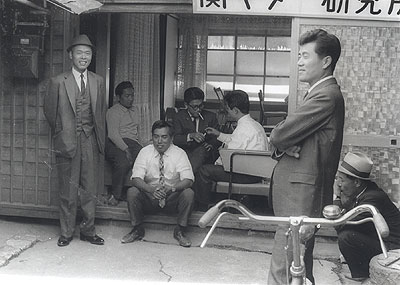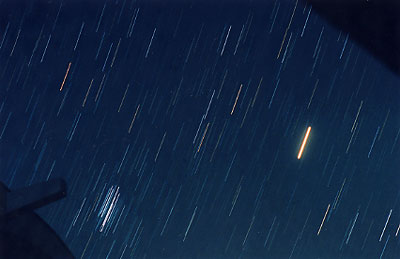• October 24
Around this time of year 40 years ago, I was running about
madly everyday trying to find out what had happened to Comet Ikeya-Seki,
which had plunged into the sun's coronas. Had it survived?
Searching for the answer, I traveled to the beaches and climbed
tall mountains. Wherever I went, I came across ordinary people who were
trying to see the comet. This is an indication of how much this comet attracted
the attention of the general public.
Mr. Koichi Ike, a professed "astronomy adventurer",
climbed Mt.Bandamori (elevation 765m) many times and made successful observations
of the comet. He confirmed the survival of the comet 7 hours before and
17 hours after perihelion from the mountain. He observed the sharp golden-color
nucleus and white vapor-like tail whose appearance changed very fast. It
was the very image of the comet violently bubbling in one million degree
heat. Excited Mr. Ike, who had the face of a rustic, unsophisticated man,
called out to the rising sun at the top of his lungs, "Hello!"
He definitely heard the echo! Yes, the comet had survived the incredible
ordeal. A spectacular show was going to commence before our eyes in cool
fall skies. Mr. Ike gave us truly miraculous observations of the comet.
Forty years later I was driving to Susaki City where I had
experienced memorable times. Passing through the Shin-Nagoya Tunnel, I
glimpsed the majestic view of distant Mt. Bandamori on the right during
the decent toward Susaki. The mountain was blurred and faint in mist, as
was my memory of the comet. Time has passed by, the stars have come and
gone, and friends have moved on. Born into this world, I want to leave
something for future generations. I feel part of my dream and aspiration
has been realized. The image of Mt. Bandamori shining in the distance persisted
in me...

Majestic Mt. Bandamori seen in the distance
Hot weather still continues in Kochi. The sun is now slightly
shifted to the south and the temperature in my upstairs study climbed to
28 degrees C. yesterday. We still need air-conditioning.
Forty years ago today, October 21, Comet Ikeya-Seki passed
perihelion. Day after day, we had very bright, magnificently clear blue
skies.

The day Comet Ikeya-Seki passed perihelion.
October 21, 1965
The comet plunged into the sun's atmosphere past noon that
day, but our house and roof (where the observing deck was) had been crowded
with reporters since the early morning. I can easily imagine that Mr. Ikeya
at Hamamatsu was experiencing the same.

Visitors gathered under the observing deck.
Mr. Koichi Ike (center) and reporters
October 21, 1965
It is extremely dangerous to observe a comet through a telescope
so close to the scorching sun. This made our attempt to see the comet very
difficult and we failed to see it during daytime. However, Mr. Koichi Ike
of Tosa City, a member of our observing team, succeeded in sighting the
comet holding its own from a mountain 7 hours earlier. The comet on its
approach to the sun was viewed during the morning by observers at Ueno
in Tokyo and Kurashiki. Some members of the general public also saw the
comet from the low-lying plains. They all saw the comet quite close to
the sun with the naked eye. Mr. M at Ueno told me that he had observed
the comet by holding a telescope's solar filter against the sun's disk.
Mr. H at Kurashiki successfully photographed the comet and reported it
to be 30 or 40 times brighter than full moon. You wouldn't be able to see
Venus or full moon if they were so close to the sun. I wonder what the
magnitude of Comet Ikeya-Seki was then. Soon after the discovery in September,
the Smithsonian Astrophysical Observatory predicted it to become the brightest
comet of the century and they were right.
It is incredible that Dr. Rigollet of France determined the
comet to be a Kreutz reaching perihelion on October 21. In those days orbits
were calculated mainly by Dr. Cunningham while Dr. Elizabeth Roemer at
Flagstaff was at her best in observing.
I looked out the window to the north and noticed a white
glow high up in the sky. I recalled that the white glows looking like snow
flakes were dancing around in the blue sky on that particular day 40 years
ago. A sound of marching band was heard, perhaps, a late-autumn sports
day at an elementary school somewhere. In my mind I was humming the song
"Comet Ikeya-Seki" composed by Jose Caleyo.
"The stars come and go, time going by, people moving on"
• October 11
This is October 11, the best part of autumn. Forty-four years
ago today, I discovered my first comet. It was a perfectly clear autumn
day. In contrast, light rain is falling today caused by the stationary
autumn rain front.
In those days I was defeated by my failure to find a comet
after more than 10 years of search and experiencing emptiness in life.
I finally parted with the 15cm reflector I had been using for many years
and began searching with the new 88mm wide-field refractor I had developed.
It was the first day I searched with the new comet seeker. I also intended
to test it.
At 4:30 am most of Leo was above the low roof in the east.
This wide-field comet seeker was developed for the purpose of searching
as much sky as possible in minimum time in twilight. It delivered 3.5-degree
field of view, so wide that it could scan most of the eastern sky in half
an hour. I used a most conventional method of sweeping by moving the telescope
horizontally, beginning at a higher altitude and gradually lowering the
telescope toward the horizon. I would usually complete the search a little
after 5 am, but that particular morning my telescope was motionless fixed
at a certain point in Leo when dawn broke. The telescope was motionless
because I found something unusual there. Close at 5 am I came across a
faint, pale glow in my field of view when I was searching against brightening
twilight. With my training and experience over 10 years I instantly recognized
it as a comet without any hesitation.
After the first discovery, whenever I discovered a comet,
I always realized that I had been able to concentrate on my search without
any distraction. In my younger days when I was searching with the 15cm
reflector, I always felt unsettled in spite of my devotion to searching.
I was always conscious of discovery and unable to see what
I should be able to see. The 88mm comet seeker was different. Its sharp
images allowed me to concentrate. The combination of a Namura lens and
33mm Erfle eyepiece was a perfect match. At the time of my first discovery,
Mr. "I", who lived 15 kilometers away, was searching the same
area as I did using a 10cm reflector at 25x, but the comet escaped his
search. The coma of this comet 2' across could be indistinguishable from
the background stars without an excellent lens and trained eye, in spite
of its 8th-magnitude brightness. Above all, the concentration of mind is
extremely important.
My first discovery was significant in that it gave me strong
confidence and taught me how ideally comet search should be.
As soon as this rain let up, I will resume searching. Only
people continuing to work actively throughout their lives will know the
happiness and excitement of living.
• October 2
On this beautiful day I visited my family grave at Hijima
in Kochi City. The place resembled a valley deep in the mountains and thick
with vegetation. I was surprised to find the graves of a number of well-known
figures, both famous and infamous, of the Edo period. I recalled that Keisan
Kawatani, an astronomical almanac scholar in the Edo period, had observed
the solar eclipse at this place. The eclipse had not been predicted on
the calendar published by the then government.
Tosa (Kochi) was blessed with great astronomers and almanac
scholars in those early days. However, it has become a prefecture far behind
the rest of the nation in various facilities, particularly in science.
Several years ago there was a plan to build a science museum in Kochi City.
The plan well progressed, but more or less faded away. Now there is a movement
behind the scenes to establish a museum or science museum. This new plan
may succeed, though it may take a long while, because this is not government-initiated
but moved by private organizations and companies. Many meetings have been
held for this purpose. There are a number of observatories of various sizes
in Kochi prefecture other than Geisei, but most of them are not very active.
Geisei's strength comes from its non-governmental beginning.
This is around the time when the autumn rain front is stationary
bringing about the worst weather conditions in the year. Forty years have
passed since Comet Ikeya-Seki was discovered. I remember that I could not
see the comet for about a week after the discovery because of bad weather.
However, around October 21 when the comet passed perihelion, we had clear
skies typical of autumn weather.
I have received a request for information from Sky &
Telescope regarding a feature to commemorate the 40th anniversary of the
discovery of Comet Ikeya-Seki. By courtesy of Mr. Eiji Kato I was able
to send them a large amount of information. There was a furious exchange
of emails at the last minute. I am looking forward to the January issue,
which will be available in December.
• October 1
We are in the autumn rainy season and there have hardly been
any clear days. On one rare fine day I was surprised that Mars looked so
close to us. Its extraordinary ruddy color was impressive. It is a fine
sight that Mars and the Pleiades are rising together above the eastern
horizon.
On October 29 there will be the autumn astronomy class held
at Geisei Observatory. In a lecture featuring Mars observation I am thinking
of talking about "The Martian Army". This is a science-fiction
written by Juza Unno in the 1930s when Martians were believed to inhabit
Mars. I still remember this interesting story even more than half a century
later. This book could have been the biggest reason for my developing interest
in the stars. Only Juza Unno as a scientist could come up with the idea
that by taking advantage of the moon's perturbation the earth's collision
with Comet Morroe was avoided. It is reported that Unno said that the earth
was blue before Gagarin said the same.

Mars and the Pleiades over the observatory dome
21:30 on October 1, 2005
85mm f/2.5 2-minute exposure on ISO400 film





